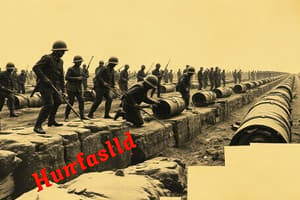Podcast
Questions and Answers
Which of the following alliances consisted of France, Britain, and Russia?
Which of the following alliances consisted of France, Britain, and Russia?
- Central Powers
- Triple Alliance
- Allied Powers
- Triple Entente (correct)
Who was assassinated in Sarajevo on June 28th, leading to the outbreak of World War I?
Who was assassinated in Sarajevo on June 28th, leading to the outbreak of World War I?
- Archduke Franz Ferdinand of Austria-Hungary (correct)
- King George V of England
- Kaiser Wilhelm II
- Tsar Nicholas II of Russia
What was the name of the plan developed by Germany to face the threat of a two-front war with France and Russia?
What was the name of the plan developed by Germany to face the threat of a two-front war with France and Russia?
- War Plan Red
- Barbarossa Plan
- Moltke Plan
- Schlieffen Plan (correct)
Which country remained neutral due to the terms of the Triple Alliance?
Which country remained neutral due to the terms of the Triple Alliance?
Why did Britain declare war on Germany?
Why did Britain declare war on Germany?
What was the initial stance of the United States in the war?
What was the initial stance of the United States in the war?
What event led to outrage and increased tensions between Germany and the US?
What event led to outrage and increased tensions between Germany and the US?
Which country joined the war on the side of the Allies and captured German territories?
Which country joined the war on the side of the Allies and captured German territories?
What was the result of the Gallipoli Campaign?
What was the result of the Gallipoli Campaign?
What was the significance of the Battle of Verdun?
What was the significance of the Battle of Verdun?
Which country declared war on Austria-Hungary in 1915?
Which country declared war on Austria-Hungary in 1915?
What was the result of the Russian attack near Lake Naroch in 1916?
What was the result of the Russian attack near Lake Naroch in 1916?
Flashcards are hidden until you start studying
Study Notes
World War I Overview
- Great Powers of Europe divided into two rival alliances: Triple Entente consisting of France, Britain, and Russia, united by fear and suspicion of Germany, the new strongest power in Europe.
- The Triple Alliance: Germany, fearing encirclement by its rivals; Austro-Hungary, tied to a brittle empire; and Italy, seeking gains at French expense.
- Spark: Archduke Franz Ferdinand of Austria-Hungary assassinated in Sarajevo on June 28th by a young Slavic nationalist.
- Austria-Hungary accuses Serbia of aiding the assassin, issues ultimatum, Serbia refuses, Austria-Hungary declares war on Serbia.
- Russia feels compelled to defend Serbia, orders military mobilization.
- Germany supports Austria-Hungary, views conflict with Russia inevitable, mobilizes its forces.
- Germany develops the Schlieffen Plan to face the threat of a two-front war with France and Russia.
- Events lead to the declaration of war between Germany and France, millions of men mobilize across Europe.
- Italy remains neutral due to the terms of the Triple Alliance.
- United States declares neutrality, President Wilson and the American public reluctant to get involved in Europe's war.
- Britain, France's ally, initially unclear about joining the war against Germany, but when Germany invades Belgium, Britain issues ultimatum and declares war.
- British Expeditionary Force lands in France, German invasion held off by Belgian resistance.
- Mass atrocities by German troops in Belgium turn neutral countries against Germany.
War Progression
- Early battles see heavy casualties on both sides, race to the sea unfolds.
- Battle of the Marne sees French and British forces stop the German advance, saving Paris.
- Trench warfare develops along a 350-mile front, leading to a stalemate.
- British navy wins the first naval battle at Heligoland Bight, establishing a blockade to Germany.
- Germany responds with submarine warfare, sinking the British cruiser Pathfinder.
- The Eastern Front sees German successes against Russia, who suffer massive losses at Tannenberg and in the Masurian Lakes region.
- In the Middle East, the Ottoman Empire joins the Central Powers and attacks Russian ports in the Black Sea.
- Conflict spreads to other regions: Africa, Asia, and the Pacific.
- Japan enters the war on the side of the Allies, capturing German territories.
- Italy joins the Allies, declaring war on Austria-Hungary.
- The year 1915 sees major battles, losses on both sides, and the introduction of new weapons such as chlorine gas.
- The war escalates globally, with strategic and humanitarian consequences.
- Fighting continues on multiple fronts, with notable battles and campaigns.
Year 1915: Turning Point
- The Lusitania's sinking by a German U-boat, killing Americans, sparks outrage.
- Germany's unrestricted submarine warfare leads to tensions with the US.
- Stalemate on the Western Front persists, with both sides entrenched.
- Russian successes in the East are countered by Austrian and German advances.
- Italy's failed offensives against Austria-Hungary in the Alps.
- The Balkan Front sees Serbia fall to the Central Powers.
- The Gallipoli Campaign ends in a costly evacuation.
- The year marks a turning point with increased casualties and a shift in strategies.
- The Battle of Verdun becomes a symbol of attrition warfare and intense fighting.
- The importance of Verdun as a symbolic and strategic objective for Germany.
- The year 1915 shapes the dynamics and outcomes of World War I.### Overview of 1916 Events
- Spring on the Western Front sees British troops as the last to be equipped with steel helmets, offering limited protection against shrapnel.
- Germany declares war on neutral Portugal, escalating the conflict.
- In the Eastern Front, Russia's attack near Lake Naroch fails to relieve pressure on the French at Verdun, resulting in heavy casualties.
- Irish republicans begin the Easter Rising against British rule in Dublin but are suppressed after six days of fighting in the streets.
- British forces in Kut surrender after a five-month siege, with General Townshend leading 9,000 British and Indian soldiers into captivity.
Developments in the Middle East and Italian Front
- Britain promises support to Arab leaders for an independent Arab state after the war, leading to the Arab Revolt against the Ottoman Empire.
- Italian forces face off against the Austro-Hungarians in the Asiago offensive, with Italian defenses crumbling.
- The German High Seas Fleet clashes with the British Grand Fleet in the Battle of Jutland, resulting in heavy losses for the British but claimed as a victory as the German fleet retreats.
Events in 1916 Continued
- Allies plan major simultaneous offensives against Central Powers from east and west to ease pressure on French and Italian fronts.
- Russia launches a successful surprise offensive under General Brusilov, breaking enemy lines and taking thousands of prisoners.
- The British cruiser HMS Hampshire sinks en route to Russia, with Secretary of State for War Lord Kitchener among the 650 casualties.
- Italian forces suffer a devastating loss as the Principe Umberto is sunk by a German submarine, resulting in around 1,900 deaths.
- The British and French launch their major summer offensives on the Western Front, notably the Battle of the Somme, which becomes one of the bloodiest battles in British military history.
- Despite initial setbacks, the Allies secure advancements in the brutal battles of 1916 with significant casualties on both sides.
Key Events of 1916
-
Unsuccessful German attempts to starve Britain through unrestricted submarine warfare lead to escalating tensions with the United States.
-
The total warfare strategy becomes evident as both sides focus on inflicting massive losses to force the opponent to surrender.
-
Russia withdraws from the war due to internal turmoil, setting the stage for a potential collapse of major European powers in 1917.
-
German leaders gamble on a final massive spring offensive in 1918 after understanding that prolonged war will lead to their defeat.
-
The year 1916 marks a turning point in the First World War, with shifting alliances and strategies that will shape the remaining years of conflict.### The End of World War I
-
Ushtritë britanike, franceze, and amerikane broke through the German Hindenburg line, a fortified defense line.
-
Ludendorff informed the Kaiser that the military situation was hopeless and Germany should seek an armistice.
-
Germany sent a request to President Woodrow Wilson, who demanded Germany's withdrawal from occupied territories and the Kaiser's abdication.
Italian Front and Austro-Hungarian Defeat
- Allied forces dealt a decisive blow to Austro-Hungary in the Battle of Vittorio Veneto.
- The Austro-Hungarian army disintegrated, and 300,000 prisoners were taken.
Armistice and Surrender
- The Ottoman Empire signed an armistice with the Allies in Mudros.
- Four days later, Austro-Hungary signed an armistice with the Allies in Villa Giusti.
- The German High Seas Fleet was ordered to launch a suicidal attack on the British navy, but instead, they mutinied.
- Revolution spread across Germany, and the Kaiser abdicated, leading to the establishment of a German republic.
- On November 11, 1918, a German delegation signed an armistice with the Allies, which took effect at 11:00 am.
Aftermath
- The Treaty of Versailles imposed harsh conditions on Germany, including limiting its army, paying war reparations, and losing territory.
- Germany was forced to accept responsibility for the war in the "war guilt clause," which led to long-lasting resentment.
- The conference of Paris established the League of Nations to resolve future international conflicts.
- The war resulted in the loss of 9.5 million soldiers, 21 million wounded, and 7 million civilians.
- The war led to the redrawing of European borders, the emergence of new states, and the transformation of the world.
World War I Overview
- Great Powers of Europe divided into two rival alliances: Triple Entente (France, Britain, and Russia) and Triple Alliance (Germany, Austria-Hungary, and Italy)
- Archduke Franz Ferdinand of Austria-Hungary assassinated in Sarajevo, leading to Austria-Hungary declaring war on Serbia
- Russia supports Serbia, mobilizes forces, and Germany declares war on Russia, leading to the declaration of war between Germany and France
- Italy remains neutral, United States declares neutrality, and Britain declares war on Germany after Germany invades Belgium
War Progression
- Early battles see heavy casualties on both sides, with a race to the sea unfolding
- Battle of the Marne stops the German advance, saving Paris, and leads to trench warfare along a 350-mile front
- British navy establishes a blockade to Germany, and Germany responds with submarine warfare
- Germany achieves successes against Russia on the Eastern Front, while the Middle East sees the Ottoman Empire join the Central Powers
- Japan enters the war on the side of the Allies, capturing German territories
- Italy joins the Allies, declaring war on Austria-Hungary
Year 1915: Turning Point
- Lusitania's sinking by a German U-boat sparks outrage and increases tensions with the US
- Germany's unrestricted submarine warfare leads to increased casualties and a shift in strategies
- Stalemate on the Western Front persists, with both sides entrenched, and notable battles and campaigns unfolding globally
- The year marks a turning point with increased casualties and a shift in strategies
Overview of 1916 Events
- Battle of Verdun becomes a symbol of attrition warfare and intense fighting
- Germany declares war on neutral Portugal, escalating the conflict
- Russian attack near Lake Naroch fails to relieve pressure on the French at Verdun, resulting in heavy casualties
- Irish republicans begin the Easter Rising against British rule in Dublin
Studying That Suits You
Use AI to generate personalized quizzes and flashcards to suit your learning preferences.




